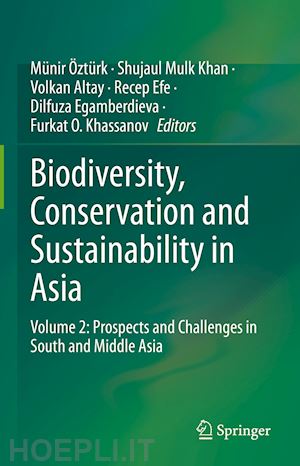
Questo prodotto usufruisce delle SPEDIZIONI GRATIS
selezionando l'opzione Corriere Veloce in fase di ordine.
Pagabile anche con Carta della cultura giovani e del merito, 18App Bonus Cultura e Carta del Docente
Of the world’s seven continents, Asia is the largest. Its physical landscapes, political units, and ethnic groups are both wide-ranging and many. Southwest, South and Middle Asia are highly populated regions which, as a whole, cover an extremely large area of varied geography. In total, this domain is unique in its plant diversity and large vegetation zones with different communities and biomes. It is rich in endemics, with specific and intraspecific diversity of fruit trees and medicinal plants, including a number of rare, high value, species. At the same time, much of the land in the region is too dry or too rugged, with many geographical extremes. Overgrazing, oil and mineral extraction, and poaching are the major threats in the area.
This two-volume project focuses on the dynamic biodiversity of the region with in-depth analysis on phytosociology, plants, animals and agroecology. There are also chapters that explore new applications as well as approachesto overcome problems associated with climate change. Much of the research and analysis are presented here for the first time. We believe this work is a valuable resource for professionals and researchers working in the fields of plant diversity and vegetation, animal diversity and animal populations, and geo-diversity and sustainable land use, among others.
The first volume guides our readers to West Asia and the Caucasus region, while volume two focuses on issues unique to South and Middle Asia.
Prof. Munir Ozturk (PhD, DSc.) specialises in the fields of Ecology & Environmental Sciences. He is the author of over 450 papers on ecological studies as well as biomonitoring in different habitats. Dr. Öztürk has received fellowships from Alexander von Humboldt and Japanese Society for Promotion of Science. He has worked at the University of North Carolina at Chapel Hill with funding from the National Science Foundation, USA. He was a Consultant Fellow at the Faculty of Forestry, University Putra Malaysia and a “Distinguished Visiting Scientist” at the ICCBS, Karachi University, Pakistan. His scientific interests include Plant Eco-Physiology; Conservation of Plant Diversity; Biosaline Agriculture and Crops; Pollution, Biomonitoring, and Medicinal/Aromatic Plants.
Dr. Shujaul Mulk Khan is currently an Associate Professor of Plant Sciences in Quaid-i-Azam University Islamabad. He is also member Pakistan Academy of Sciences. He served as Lecturer in Botany for nine years in Hazara University, Pakistan. He obtained his PhD in Biology from University of Leicester, UK in 2012 as a nominee for the best thesis award in the School of Biological Sciences followed by a Post Doctorate from the Centre for Landscape and Climate Research, University of Leicester, UK. His research mainly focuses on Plan Ecology & Conservation of the Himalayas. He has published 3 books, 10 book chapters, 112 research papers in journals with an impact factor of more than 200. He also published more than 130 abstracts in conference proceedings.
Dr Volkan Altay is an Assoc. Professor of Ecology and Environmental Sciences at the Botany Department of Hatay Mustafa Kemal University, Turkey. His fields of scientific interest are Plant Ecology, Taxonomy, Biodiversity, Biomonitoring, and sustainable use of medicinal plants. He received his PhD. in 2009, has a proven track record of over 30 research publications in highly reputed professional journals. He has also published 1 book with Springer.
Dr Recep Efe, Professor of Geography and Ecology at Balikesir University, obtained his PhD in Geography from Istanbul University. An active researcher with research interests spanning over a wide range of topics in geography, biogeography and ecology, he has over 200 publications with more than 120 papers in national and international scientific journals. Dr. Efe has authored and co-authored/edited 60 books and 18 book chapters in Turkish and English. He is member of International Geographical Union (IGU), Association of American Geographers (AAG), International Associations of Geomorphologists (IAG), International Association of Hydrological Sciences (IAHS-6648), Balkan Geographical Association, Turkish Geographical Association.
Dr. Dilfuza Egamberdieva received her PhD in Agricultural Sciences from the Humboldt University of Berlin, Germany in 2000. She conducted her postdoctoral studies at the Helsinki University of Finland, University of Florence, Manchester Metropolitan University, and Leiden University of Netherlands. She has a long-term experience in plant and soil biotechnology research and has collaborated widely with scientists across the world. She served as international project coordinator in her home country on a variety oftopics, including soil improvement, crop productivity, food security and sustainable management of natural resources. She is member of the Asian PGPR Society for Sustainable Agriculture. Dr. Egamberdieve is the recipient of numerous fellowships and awards, including the UNESCO-L’OREAL Fellowship for Women in Science, Alexander Von Humboldt Fellowship. In 2012 she recieved the TWAS Prize in Agricultural Sciences for her contributions to the study of plant-microbe interactions in stressed environments. She is a member of several journal editorial boards, the author of four books, and co-author of over 100 publications related to plant nutrition, agricultural biotechnology and soil fertility.










Il sito utilizza cookie ed altri strumenti di tracciamento che raccolgono informazioni dal dispositivo dell’utente. Oltre ai cookie tecnici ed analitici aggregati, strettamente necessari per il funzionamento di questo sito web, previo consenso dell’utente possono essere installati cookie di profilazione e marketing e cookie dei social media. Cliccando su “Accetto tutti i cookie” saranno attivate tutte le categorie di cookie. Per accettare solo deterninate categorie di cookie, cliccare invece su “Impostazioni cookie”. Chiudendo il banner o continuando a navigare saranno installati solo cookie tecnici. Per maggiori dettagli, consultare la Cookie Policy.